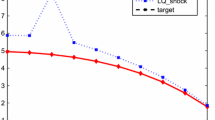Abstract
Zoutendijk's method of feasible directions is used in this paper to derive numerical control strategies for the United Kingdom economy. The way in which the algorithm permits an examination of the sensitivity of the optimum short-term economic policy to changes in various assumptions demonstrates the versatility of the algorithm. Examined are the implications of different forms for the social welfare function; altering the length of the planning horizon, varying the magnitude of the terminal capital constraint, reducing the maximum permitted level of unemployment, changing the initial endowment of foreign currency reserves, fixing the interest rate for the whole planning period, and imposing a minimum growth rate for public expenditure.
Similar content being viewed by others
References
Pindyck, R. S.,Optimal Planning for Economic Stabilization, North-Holland Publishing Company, Amsterdam, Holland, 1973.
Livesey, D. A.,Can Macro-Economic Planning Problems Ever Be Treated as a Quadratic Regulator Problem?, IEE Conference Publication, Vol. 101, pp. 1–14, 1973.
Livesey, D. A.,Optimising Short-Term Economic Policy, Economic Journal, Vol. 81, pp. 525–546, 1971.
Livesey, D. A.,Some Aspects of the Theory of Economic Policy, Paper Read at the European Meeting of the Econometric Society, Grenoble, France, 1974.
Tinbergen, J.,On the Theory of Economic Policy, North-Holland Publishing Company, Amsterdam, Holland, 1952.
Preston, A. J.,A Dynamic Generalization of Tinbergen's Theory of Policy, Review of Economic Studies, Vol. 41, pp. 65–74, 1974.
Lasdon, L. S., Mitter, S. K., andWarren, A. D.,The Conjugate Gradient Method for Optimal Control Problems, IEEE Transactions on Automatic Control, Vol. AC-12, pp. 132–138, 1967.
Polak, E.,A Survey of Methods of Feasible Directions for the Solution of Optimal Control Problems, IEEE Transactions on Automatic Control, Vol. AC-17, pp. 591–596, 1972.
Zoutendijk, G.,Method of Feasible Directions, Elsevier Publishing Company, Amsterdam, Holland, 1960.
Wolfe, P.,On the Convergence of Gradient Methods under Constraints, IBM Research Report, RC 1752, Yorktown Heights, New York, 1967.
Armijo, L.,Minimization of Functions Having Continuous Partial Derivatives, Pacific Journal of Mathematics, Vol. 16, pp. 1–3, 1966.
Cullum, J.,Finite-Dimensional Approximations of State-Constrained Continuous Optimal Control Problems, SIAM Journal on Control, Vol. 10, pp. 649–670, 1972.
Polak, E.,Computational Methods in Optimization: A Unified Approach, Academic Press, New York, New York, 1971.
Polak, E.,On a Class of Numerical Methods with an Adaptive Integration Sub-procedure for Optimal Control Problems, Proceedings of the Fourth IFIP Colloquium on Optimization, Santa Monica, California, 1971.
Author information
Authors and Affiliations
Additional information
Communicated by P. Varaiya
This work was supported in part by the National Science Foundation, Grant No. GK-10656X7.
Rights and permissions
About this article
Cite this article
Livesey, D.A. Feasible directions in economic policy. J Optim Theory Appl 25, 383–406 (1978). https://doi.org/10.1007/BF00932901
Issue Date:
DOI: https://doi.org/10.1007/BF00932901




